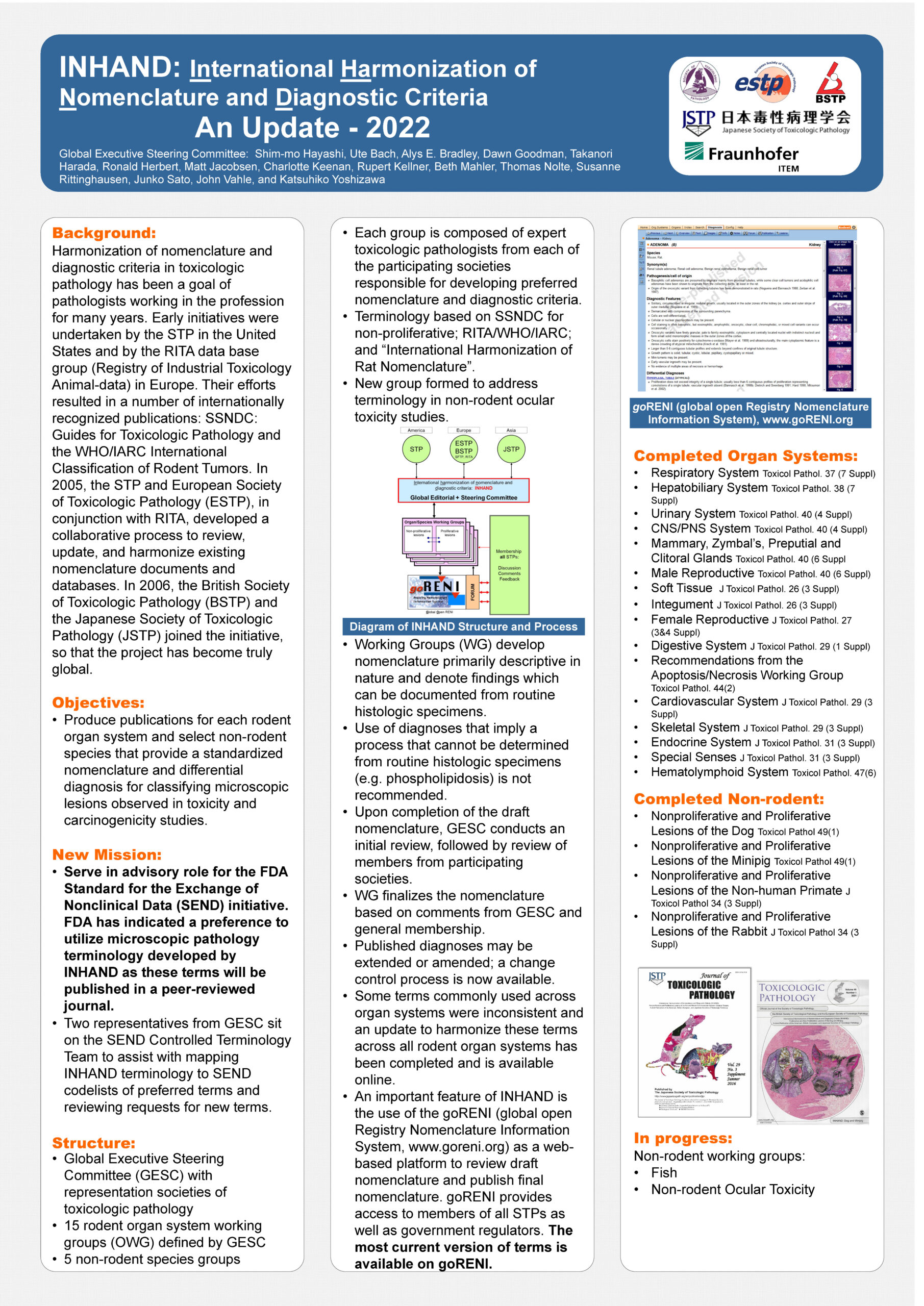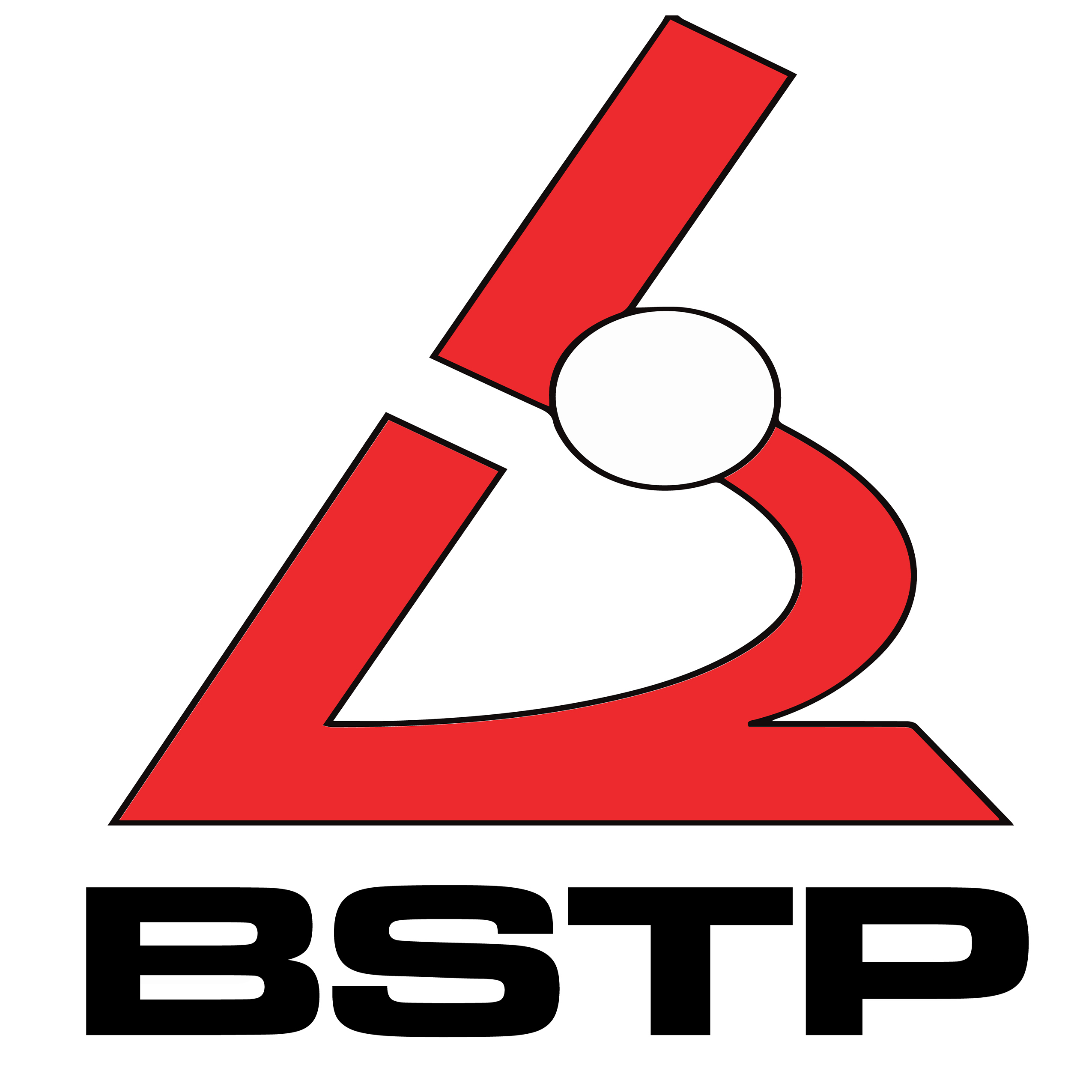The INHAND Project (International Harmonization of Nomenclature and Diagnostic Criteria for Lesions) is a joint initiative of the STP, BSTP, ESTP and JSTP to develop an internationally-accepted nomenclature for proliferative and non-proliferative lesions in laboratory animals. An Organ Working Group (OWG) comprised of experts in that organ system prepares draft nomenclature for both proliferative and non-proliferative lesions of the rat and mouse. Prior to finalization, proposed nomenclature for each organ system will be posted on the goRENI website (www.goreni.org) for comments from members from any of the participating societies.

INHAND Non-rodent Working Groups.
INHAND has established 5 non-rodent working groups (NRWG) – non-human primate, dog, mini-pig, rabbit and most recently fish. These groups are following goals and objectives similar to the rodent organ working groups:
- NRWG should evaluate and consider previously available nomenclature resources – appropriate literature as well as published INHAND rodent manuscripts, GoRENI, and SSNDC. (GoRENI at www.goreni.org; SSNDC at www.toxpath.org – click on Publications and Links; Standardized Nomenclature: SSNDC Guides)
- Scope of work for each NRWG will include nomenclature for proliferative and non-proliferative lesions for the non-rodent species.
- Spontaneous as well as common induced lesions.
- Seek broad input of the toxicologic pathology community on draft manuscripts
- Finalize manuscripts and compile into a format suitable for publication.
.
Standardized nomenclature will be addressed using the principles outlined in the INHAND proposal. In general, the working groups will develop nomenclature that is primarily descriptive in nature and denote findings which can be documented from the review of routine histologic specimens. NRWG will develop a preferred term but also may note previously used terms for each lesion under consideration. As much as possible, additional fields and modifiers should be uniform across organ systems.
While the groups are using the currently published rodent INHAND documents, SSNDC guide (if available) and appropriate literature reference, it is understood that certain species/systems may need terms that are not covered in these documents and these will be addressed. The NRWGs are using a series of tables for each organ system, outlining the diagnoses from previously published INHAND rodent systems. The diagnoses will fall under one of 4 categories: Common, Uncommon, Not Applicable, Not observed/Relevant. If a diagnosis has distinctive morphologic criteria and/or comments appropriate to the species, these will be covered in a brief text. Diagnoses that are unique to the species will have a full outline similar to the format in the rodent publications.
As part of evaluating standardized terminology, the groups have developed a proposal for assessment of skeletal and sexual maturity. Recording an overall assessment of sexually immaturity or maturity has not been standard practice in general non-clinical toxicology studies. Inclusion of this information may be helpful in interpreting risk assessment for juvenile or adult populations and could limit the need for additional studies. Providing comment on the stage of maturity when using (peri)pubertal animals in toxicity studies can be helpful since varying stages of maturity can hamper judgment on possible reproductive effects. The current industry practice is to include specific reproductive end points on a case by case base (Halpern et. al., 2016).
The INHAND proposal is currently under review by the SEND Controlled Terminology and Core Teams, to determine if additional data fields will be needed in SEND to accommodate the maturity information.
INHAND and collaboration with the FDA on SEND – Background and Current Status
Keenan, CM1, Baker, J2, Bradley, A3, Goodman, DG4, Harada, T5, Herbert, R6, Kaufmann, W7, Kellner, R8, Mahler, B6, Meseck, E9, Nolte, T10, Rittinghausen, S8, Vahle, J11, Yoshizawa, K12
1CM Keenan ToxPath Consulting, Doylestown, PA, 2Charles River, Frederick, MD, 3Charles River, Tranent, Scotland, UK, 4Independent Consultant, Potomac, MD, 5The Institute of Environmental Toxicology, Joso-shi, Ibaraki, Japan, 6NIEHS, Research Triangle Park, NC, 7Merck KGaA, Darmstadt, Germany, 8Fraunhofer ITEM, Hannover, Germany, 9Novartis Institute for Biomedical Research, East Hanover, NJ, 10Boehringer Ingelheim Pharma GmbH & Co. KG, Biberach an der Riss, Germany, 11Eli Lilly & Company, Indianapolis, IN, 12Kansai Medical University, Hirakata, Osaka, Japan
The INHAND Proposal (International Harmonization of Nomenclature and Diagnostic Criteria for Lesions in Rats and Mice) has been operational since 2005. A Global Editorial Steering Committee (GESC) manages the overall objectives of the project and the development of harmonized terminology for each rodent organ system or non-rodent species is the responsibility of the Organ Working Groups (OWG) or Non-rodent Working Groups (NRWG) respectively, drawing upon experts from North America, Europe and Japan.
Great progress has been made with 9 rodent organ systems published to date – Respiratory, Hepatobiliary, Urinary, Central/Peripheral Nervous Systems, Male Reproductive and Mammary, Zymbals, Clitoral and Preputial Glands in Toxicologic Pathology and the Integument and Soft Tissue and Female Reproductive System in the Journal of Toxicologic Pathology as supplements and on a web site – www.goReni.org. INHAND nomenclature guides offer diagnostic criteria and guidelines for recording lesions observed in rodent toxicity and carcinogenicity studies. The guides provide representative photo-micrographs of morphologic changes, information regarding pathogenesis, and key references.
During 2012, INHAND GESC representatives attended meetings with representatives of the FDA Center for Drug Evaluation and Research (CDER), Clinical Data Interchange Standards Consortium (CDISC), and the National Cancer Institute (NCI) Enterprise Vocabulary Services (EVS) to begin incorporation of INHAND terminology as preferred terminology for SEND (Standard for Exchange of Nonclinical Data) submissions to the FDA. The interest in utilizing the INHAND nomenclature, based on input from industry and government toxicologists as well as information technology specialists, suggests that there will be wide acceptance of this nomenclature.
INHAND document on Female Reproductive System published in JTP is available on line for open access to the following website:








